#modular synthesiser
Explore tagged Tumblr posts
Video
youtube
NASA ARP
A stochastic experiment with two ARP 2600s.
The ARP synthesiser was invented by Alan Robert Pearlman, a NASA engineer, in 1969.
The ARP 2500 was used in the 5 notes sequence of the film Close Encounters of the Third Kind, played by Phil Dodds, of ARP.
https://on.soundcloud.com/DyHXt
#youtube#electronicmusic#synthesizer#modular synthesis#subtractive synthesis#additive synthesis#modular synthesiser#arp2600#nasa#space#ambient music#ambient#ethereal#eerie#soundscape#science fiction#scifi#close encounters of the third kind
2 notes
·
View notes
Text
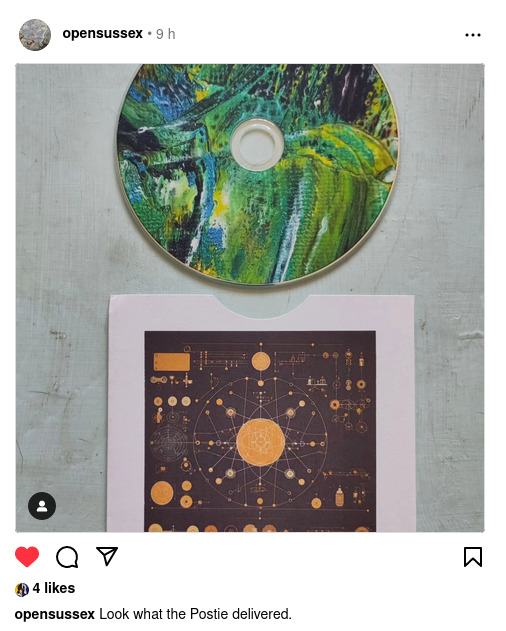
I HAZ A NEW ALBUM OUT.
TRANSIENT SOLIDS by BRAM Van BARTEK
"Lo-Fi science-fiction music from a parallel-1980s: eccentric, slowly evolving minimal electronic poly-rhythms that stumble and trip over their own analogue shoelaces. Raw, unpolished synth sequences that unzip and unspool themselves like broken DNA helices. File under: Failed Futures." Available as a digital download or a super-limited physical CD here:
#music#electronic music#electronics#electronic#synthesizer#ambient#bandcamp#synthesiser#synthesis#modular#modular synth#modular synthesizer#analogue#analogue synth#Bandcamp
5 notes
·
View notes
Text
The latest 50 from Invisible Club.
#invisible club#spotify#mixcloud#electronic music#experimental electronica#trevlad sounds#krautrock#synthesiser#modular synthesizers#electronic#ambient music#instrumental#nowplaying#experimental#ambient
0 notes
Text
number two reason i could not own a large modular synthesiser is cost. number one reason is i would absolutely bone the shit out of that beautiful machine
3K notes
·
View notes
Text
Blade Runner soundtrack at 30: how Vangelis used electronic music to explore what it means to be human
by Alison Cole, Composer and Lecturer in Screen Composition, Sydney Conservatorium of Music at the University of Sydney

In June 1994 the late composer Evangelos Odysseas Papathanassiou – better known as Vangelis – released his soundtrack for the 1982 film Blade Runner. It would go on to become emblematic of his skills, with only a handful of soundtracks reaching a similar level of cult status.
Prior to this, sci-fi film scores tended to be characterised by orchestral sound palettes. For instance, John Williams’ 1991 Star Wars soundtrack leaned on the London Symphony Orchestra to communicate the vastness of a galaxy far, far away.
Vangelis, on the other hand, used an electronic approach to bring a subtlety and complexity that shifted the focus inwards. His ability to communicate deep emotion, alongside expansive philosophical concepts, was perhaps his greatest achievement with Blade Runner.
Missing pieces
Director Ridley Scott’s Blade Runner was adapted from Phillip K. Dick’s 1968 sci-fi novel Do Androids Dream of Electric Sheep? – which itself was a thoughtful examination of empathy and what it means to be human. The emotional gravitas of the original story, along with Vangelis’ accompanying timbral exploration, created an aural experience that was new to sci-fi films at the time.
Vangelis began work on the score in 1981. He received edited footage scene-by-scene on VHS tapes and created live takes in his studio with his synthesiser collection.
However, the first official soundtrack was delayed some 12 years after the film’s release, due to what was reportedly an ongoing disagreement with producers.
When it finally was released, purists viewed it as more of an album than a soundtrack. They criticised it for not having much of the music used in the original film, and for including pieces that never appeared in the film, such as Main Titles and Blush Response.
While the 2007 version (a 25th anniversary edition) included some unreleased material, parts of the original soundtrack remain unreleased even today.
A symmetry between newness and nostalgia
By emphasising longer drawn out notes, rather than thick instrumental combinations, Vangelis thoughtfully taps into the atmosphere of Scott’s visual world to create something truly unique.
Early sci-fi movies such as Forbidden Planet (1956) and The Day The Earth Stood Still (1951) often used electronic instruments developed in the early to mid-1900s, such as the theremin and the modular synthesiser. While these instruments helped augment concepts such as aliens, spaceships and robots, they did this somewhat simplistically.
A more sophisticated perspective pervades through Blade Runner, which combines film-noir instrumentation with classical, electronic, jazz and Middle Eastern music genres.
Specifically, Vangelis leverages the different sound qualities of synthesisers – such as bright and airy, thin and cold, or dark and thick – to at once capture emotion and highlight the complex ideas in the film’s narrative. In the final act, expansive synths dominate as the film reaches an intellectual and emotional climax.
While the synthesisers lend an artificial timbre to the score, the musicality simultaneously communicates life and feeling. In this way the foreign and familiar became enmeshed.
The film’s retro costuming and brutalist architecture also set up an expectation for the soundtrack. At times, the score will meaningfully go against this expectation by delving into a more nostalgic sound. The track Love Theme is a perfect example.
Innovative takes
Vangelis’ innovative use of dialogue in the soundtrack also helped to translate the complexities of the human condition. The tracks Main Titles, Blush Response, Wait for Me and Tears in Rain all feature dialogue in a way that makes them feel like a part of the film’s DNA.
The soundtrack’s arrangement was also uncommon for its time, as it mirrored the action narrative sequence. Tracks 1 through 4 are mixed as a single ongoing track. Tracks 5 through 7 are separated by silence, while tracks 8 through to 12 are also combined into a single piece. While this technique is common in electronic composition now, it was unique at the time.
The films dark, fraught and sad dystopian themes are further highlighted through collaborations with Welsh singer Mary Hopkins in Rachel’s Song, and Greek singer Demis Roussos in Tales of the Future.
Today, the Blade Runner soundtrack remains the most beloved of Vangelis’ works by his ardent fans – and it continues to commands its place in the 20th-century electronic music canon.
#movies#art#science fiction#cyberpunk#movie soundtrack#Blade Runner#Vangelis#sounds like science fiction#electronic music
62 notes
·
View notes
Note
what’s wrong with the maintenance phase podcast? <- doesn’t listen to podcasts voice i just like hearing you complain about things
wikipedia slop. like reading a meta-review of slate dot com articles written by bernie stans who understand science with the approximate critical inquiry of auguste comte. and then people will call it "nuanced" and "interesting" because the hosts are not deep enough thinkers to even synthesise any of their brooklyn journo friends' articles into coherent arguments and instead they just construct frankensteinian eclectic stances out of modular rearrangements of fundamentally philosophically incompatible arguments by phrasing them as localised caveats
27 notes
·
View notes
Text


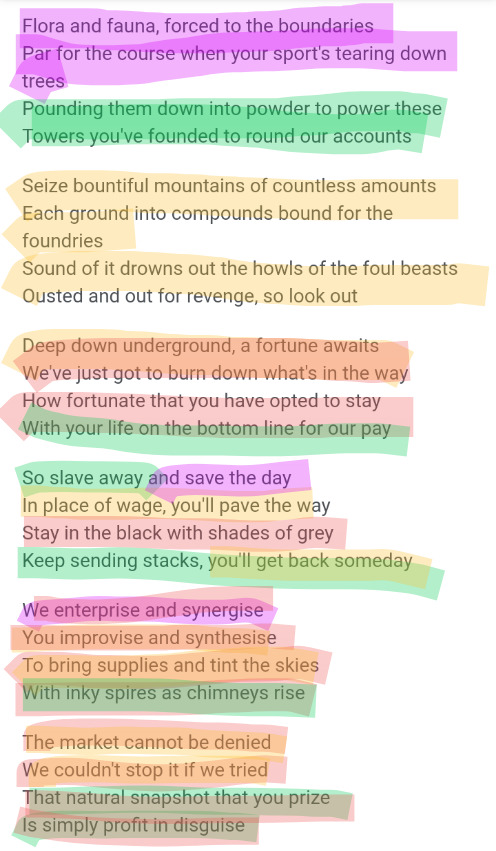
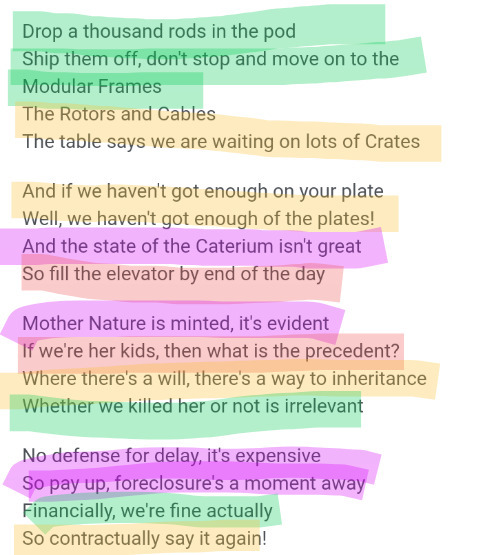
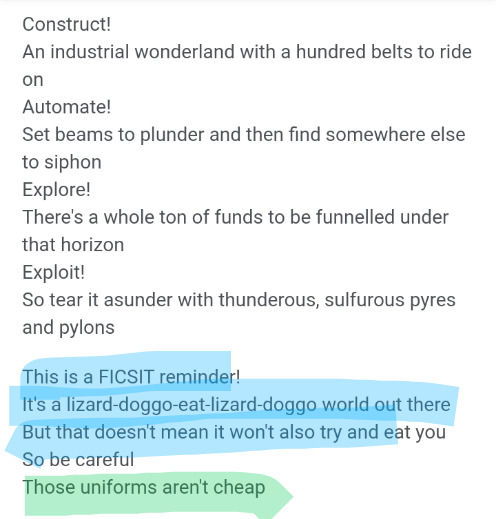


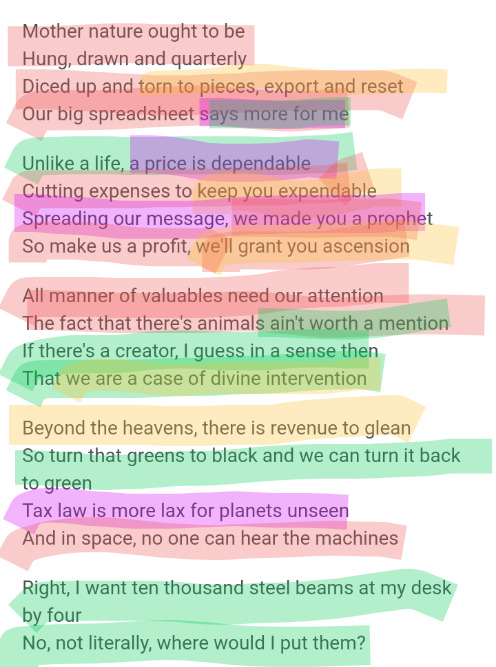
I did it again
Welcome from FICSIT Inc. to our brand new engineer
We're thrilled you picked us, we're here to bring you a brilliant new career
Yes, it's true that the terms of your servitude are a little bit unclear
But don't fear the years you'll be spending here, you're a lifelong pioneer!
You're entering planetfall to a planet full of resources
Your contract calls that your life revolves around rounding up and exporting
And if you happen upon our previous ones, well, it's your job to report it
Take inventory of the spent debris, but best to leave any corpses
No time for grief, so take relief in this briefing
These core values, FICSIT needs you believing
You'd better learn them if you want to be leaving
But if you miss it, then we'll keep on repeating
Construct!
Rebrand that land before you as a grandiose factory floor
Automate!
Command it to handle it, so you're free to construct more
Explore!
You'll fall to a world of wonders that none have seen before
Exploit!
Convert that fertile earth to a furnace for churning ore
Flora and fauna, forced to the boundaries
Par for the course when your sport's tearing down trees
Pounding them down into powder to power these
Towers you've founded to round our accounts
Seize bountiful mountains of countless amounts
Each ground into compounds bound for the foundries
Sound of it drowns out the howls of the foul beasts
Ousted and out for revenge, so look out
Deep down underground, a fortune awaits
We've just got to burn down what's in the way
How fortunate that you have opted to stay
With your life on the bottom line for our pay
So slave away and save the day
In place of wage, you'll pave the way
Stay in the black with shades of grey
Keep sending stacks, you'll get back someday
We enterprise and synergise
You improvise and synthesise
To bring supplies and tint the skies
With inky spires as chimneys rise
The market cannot be denied
We couldn't stop it if we tried
That natural snapshot that you prize
Is simply profit in disguise
Drop a thousand rods in the pod
Ship them off, don't stop and move on to the Modular Frames
The Rotors and Cables
The table says we are waiting on lots of Crates
And if we haven't got enough on your plate
Well, we haven't got enough of the plates!
And the state of the Caterium isn't great
So fill the elevator by end of the day
Mother Nature is minted, it's evident
If we're her kids, then what is the precedent?
Where there's a will, there's a way to inheritance
Whether we killed her or not is irrelevant
No defense for delay, it's expensive
So pay up, foreclosure's a moment away
Financially, we're fine actually
So contractually say it again!
(i couldn't be bothered to color this next section in)
Construct!
An industrial wonderland with a hundred belts to ride on
Automate!
Set beams to plunder and then find somewhere else to siphon
Explore!
There's a whole ton of funds to be funnelled under that horizon
Exploit!
So tear it asunder with thunderous, sulfurous pyres and pylons
This is a FICSIT reminder!
It's a lizard-doggo-eat-lizard-doggo world out there
But that doesn't mean it won't also try and eat you
So be careful
Those uniforms aren't cheap
You've been hurled without leave to build worlds without leaves
Scorch the earth, burn the trees, crush the birds, squash the bees
Yes, the customer may moan, kicking creatures from their home
But they'll scream and rant and rave if they don't get their mobile phone
You may think that it's a lot, slaying nature so our stocks gain
You may rethink extinction when your neck is on the Blockchain
All things bright and beautiful, all creatures great and small
Will be scanned and logged and processed for the shareholder's bankroll
It's a little bit of sweat, a little bit of toil
And a big blind eye to the wildlife spoiled
If they go the way of the dinosaur
What you crying for? We're just making oil!
So the seas may boil and the skies might burn
But we'll reap the spoils of the prize you've earned
No quarrel, it's morally grey, just quarry away
Morals make for downturn
Mother nature ought to be
Hung, drawn and quarterly
Diced up and torn to pieces, export and reset
Our big spreadsheet says more for me
Unlike a life, a price is dependable
Cutting expenses to keep you expendable
Spreading our message, we made you a prophet
So make us a profit, we'll grant you ascension
All manner of valuables need our attention
The fact that there's animals ain't worth a mention
If there's a creator, I guess in a sense then
That we are a case of divine intervention
Beyond the heavens, there is revenue to glean
So turn that greens to black and we can turn it back to green
Tax law is more lax for planets unseen
And in space, no one can hear the machines
Right, I want ten thousand steel beams at my desk by four
No, not literally, where would I put them?
#wonderlands x showtime#wxs#wxs tsukasa#wxs emu#wxs rui#wxs nene#wxs miku#slightly#a matter of factories#the stupendium#project sekai#pjsk#gonna be honest#this one is a bit more intense than their usual music#but it would sound good in their voices#also sorry if this feels a bit rui heavy at the end#or if it feels unbalanced in any way really#in my defense#i need to sleep
7 notes
·
View notes
Text

LE069 Sam Prekop Spelling
Sam Prekop’s boundless imagination is guided by his strong sense of melody. For more than 25 years, as a solo artist or as part of The Sea and Cake, Prekop creates a singular sound inventive and warm. His distinctive vocals, guitar playing and work on modular analog synthesisers are inventive, delicate, and always bear his signature sense of melody.
Artist notes: Listening like a photographer waiting on the light. Walking in a straight line, still meandering. It’s a wonder we get anywhere and so it goes on, just like we had hoped. One moment after another, catching up and loosing speed, keeping pace, waiting on the light. As it gets darker the sound is longer, heavier, there is less time, but it’s worth waiting for.
5 notes
·
View notes
Text
Domenico Lancellotti - sramba
Tom Zé, Faust and João Gilberto collide in Domenico Lancellotti’s “machine samba” It’s midwinter in Lisbon and Domenico Lancellotti has invited Ricardo Dias Gomes to stay for a while. They waste no time in doing what they always do, heading down to their underground studio, appropriately nicknamed The Cave, to make music. The fact that Ricardo had just been sent a bunch of Russian-designed synths and was eager to try them out, instantly signalled a direction for the album. “Ricardo had his instruments, modular machines” remembers Domenico, “and I had my guitar, some percussion instruments. On the first day we started making sounds and recording them, and songs started to appear, sambas started to appear.” In just a couple of months the duo recorded the majority of what would become SRAMBA, an album that reaches back to the roots of samba, but does so whilst completely revamping its blueprint, indoctrinating guitar and percussion-led rhythms with analogue synthesisers, Ricardo’s beloved machines. Domenico and Ricardo instantly saw how the synthesisers were not at odds with the sambas they were playing, instead they had a similar sound to its typical percussion instruments (ganza, repinique, surdo, tarol). What’s more, they saw a connection with roots samba, the samba that existed before bossa nova and samba jazz came along. This was rhythmic samba, with grooves that could go on ad infinitum. “It’s samba de clave, geometrically structured” says Domenico. “It’s ostinato samba”, adds Ricardo. Both Domenico Lancellotti and Ricardo Dias Gomes are revered names within Brazilian music over the past 20 years. As a member of the +2’s, with Moreno Veloso and Kassin, Domenico released a trio of albums on Luaka Bop in the early 00s that pioneered a new Rio samba sound with elements of funk and psychedelia. With Veloso and Kassin he would later form Orquestra Imperial, a big band intent on reviving ballroom (gafieira) samba, and that has worked with guest vocalists such as Seu Jorge, Elza Soares and Ed Motta. SRAMBA is his fourth solo album. Multi-instrumentalist Ricardo Dias Gomes first came to notice as a member of Caetano Veloso’s band Cê which helped reinvigorate Caetano’s career with a sound influenced by British new wave. As well as collaborations with Lucas Santtana, Negro Leo and Thiago Nassif, and work with his own group Do Amor, he has released a series of acclaimed solo albums that reveal a restless music-maker. Domenico- guitarras, voz, mpc-1000, bateria eletrônica, caxixi Ricardo- baixo, bateria eletrônica, rodhes Aquiles Morais-trompete Everson Morais- trombone Arranjo de metais- Aquiles Morais
21 notes
·
View notes
Text
Thorsten Soltau [Glaciers]

Release date: February 01, 2025 Catalog no. zappak-021
Bandcamp Page: https://zappak.bandcamp.com/album/glaciers
[Tracklist]
Glaciers
Excerpt: https://soundcloud.com/zappak/zappak-021
Thorsten Soltau: field recordings, voice, text-to-speech, reed organ, electric cello, modular system and granular synthesis
Finalized and edited in 2023 Remastered in 2024 at Studio >Lichter Raum<
Design and layout by Leo Okagawa Photography by Thorsten Soltau
Illustrations based on photographs and oil paintings from the Karl-Werner Feyen archive
Special thanks: Imke Feyen, Astrid Susanna Schulz, John Ihlo, Stefan Guba, and Leo Okagawa
—
"Remembering someone who has passed away is not an easy task. It is both challenging and demanding. Depending on one‘s closeness to the person, the task varies between being a chronicler and coming to terms with the person‘s life. This publication belongs to the latter. It is an approach to a friendship with a person who has accompanied me closely for more than 20 years of my life: Karl-Werner Feyen.
The photos used in the insert were taken a week after Werner's death, both inside and outside his home. The portrait on the CD dates from 2017, and the illustrations on the outer sleeve were created using photographs and oil paintings from the archive."
Formed and shaped over the course of a year, 'Glaciers' is a listening piece and requiem. It uses sounds recorded while clearing out the apartment of his closest friend Karl-Werner Feyen after his death.
Five segments commemorate a life and a friendship in a dense composition, highlighting several key points of the deceased's life. Mixing in situ soundscapes with field recordings and synthesised variations, 'Glaciers' builds complex layers of electro-acoustic sounds. Spoken words from dictaphones and text-to-speech synthesis provide further biographical clues.
"Werner was a close friend who influenced me greatly," Thorsten Soltau recalls. Spending more than 20 years together formed a very close bond. "Werner was an unusual person and a hermit. He trusted few people and lived a life that most people would not pursue. However, Werner retained a very warm and gentle side". That trust was to be extended when Werner asked Thorsten Soltau to take pictures of the murals he had painted on the flat walls. "In case he died, he said, please take pictures and preserve what I have written and painted here," explains Thorsten Soltau. A small selection of the photographs were used for the sleeve design and can also be downloaded with the purchased album.
—
Thorsten Soltau is a Germany-based artist who has been working since 2009. Until now his works were released on labels focusing on noise/soundscape such as Auf Abwegen, Gerauschmanufaktur, Chondritic Sound, Sentimental Productions, and so on. [Glaciers], dedicated to his lost friend, is a 31.5 minutes long piece and it is filled with ambience and electronic drone. The tones are sometimes gentle and warm, and sometimes melancholy. There are sounds of objects, voices, electronic sounds, and various other sounds flying in and out of the drones, as if we are listening to a requiem or watching the flashback of Soltau's friend's whole life.
Thorsten Soltauは2009年からドイツを拠点に活動しているアーティスト。これまでにAuf Abwegen、Gerauschmanufaktur、Chondritic Sound、Sentimental Productionsなどといったノイズ/音響系のレーベルから作品を発表してきている。 本作[Glaciers]は今はなき彼の友人に捧げられた作品であり、31分半のなかでアンビエンスに満ちた電子音のドローンが鳴り響く。その音色はときに優しく暖かく、ときに深い悲しみをまとっている。さらに物音や人の声、電子音などといったさまざまな音がドローンのなかで飛び交っては消えていくその様子は、まるでレクイエムを聴いているか、または走馬灯を見ているかのようでもある。
—
Thorsten Soltau

Thorsten Soltau is a self-taught artist who has been working in the field of micro-sound and glitch since 2005. Recent compositions are arranged for elements of new classical music, drone and sound design. Fields of interest include sonic disintegration, conceptualism and dualism in philosophy, and gender-related issues. Thorsten Soltau is a citizen of KonungaRikena Elgaland-Vargaland. He lives in Friesland, Lower Saxony (Germany). www.thorstensoltau.de
2 notes
·
View notes
Text

"For you, I give and give away my unhappiness in color. For the abandoned hearts to see them, to bloom into your world"
SCREAMO is the Omnitrix's DNA sample of a Sonorosian, from the planet Sonorosia
While retaining the similar build of his species, this Sonorosian in particular has had some "upgrades" to say the least. His head is comprised of a screen, and through it he can express his emotions throughout emoticon-styled faces. His mouth also moves whenever he speaks, so it's not a case of just still images on a screen whenever he feels a certain way or wants to say something. The screen is not made through just any regular material, it's quite resistant to sound waves, which is what ends up allowing him to still emit his sonic screams through his mouth, like a regular Sonorosian.
Oddly enough, unlike the rest of his species, he has hair. Long, jet black hair, with red roots, swept to the side and covering part of the right side of his face. He sports a blue long-sleeve shirt, with the sleeves usually covering part of his hands, apart from where the wires that connect to his back are placed. The Omnitrix is placed on his left wrist, seemingly attached like in its original form: a watch, but less overcomplicated and more practical. He also appears to wear black jeans, adorned & fastened with a white belt, with some white converse shoes to match. His body is a mixture of both electronics and a really malleable silicone that does not hold back his movements. His hands contain wires that are connected to his back, each of them representing left and right. Beneath his shirt, many more wires are connected to several audio ports on his back, similar to that of a modular synthesiser.
Similar to a previous transformation, the Sonorosian does not take a vicious, deadly form, but rather a more adorable, child-like form, seemingly bringing out more innocence and blissful ignorance from the user, rather than anger and depravity that end up disfiguring the forms, which supports the theory that it amplifies and makes certain emotions and traits into the identity of each form, according to both the species and the user. Another thing that stands out to anybody that knows the Sonorosian species' biology in and out, is that SCREAMO possesses discs that emit the same loud sounds that he can, which is something that usually is something that only Evolved Sonorosians have.
Abilities:
Audiokinesis
Sonic Screams
Duplication/Cloning
Sonic Discs
Connecting to audio technology
Modular Synthesis
Enhanced Strength
Enhanced Durability
Enhanced Jumping
Enhanced Acrobatics
Enhanced Reflexes
Weaknesses:
Small Size
Fire Vulnerability
Electricity Vulnerability
Killable Clones
Immobilisation by Ice
Vulnerable to Illness
#b10#ben 10#ben 10 omniverse#ben 10 series#fanfiction#art#artwork#ben 10 alien force#ben 10 fanart#ben 10 oc#ben 10 ultimate alien#ben ten#ben 10 fandom#ben 10 fanfiction#ben 10 au#omnitrix#ben 10 omnitrix#ben 10 classic#oc#echo echo#sonorosian
3 notes
·
View notes
Text
Drone Phase
Ayamikhan · Drone Phase
https://on.soundcloud.com/pzm6m
An experiment with Oberheim SEM.
#electronic music#additive synthesis#modular synthesis#subtractive synthesis#synthesiser#stochastic music#ambient#soundscape#oberheim#sem
0 notes
Text
modular synthesiser would be such a cute name for a baby girl
3 notes
·
View notes
Text
More Notes on the Computer Music Playpen
I have finished maintenance on the VST3 plugin opcodes for Csound, Csound for Android, and some other things, and am re-focusing in composition.
One thing that happened as I was cleaning up the VST3 opcodes is that I discovered a very important thing. There are computer music programs that function as VST3 plugins and that significantly exceed the quality or power what Csound has so far done on it own, just for examples that I am using or plan to use:
The Valhalla reverbs by Sean Costello -- I think these actually derive from a reverb design that Sean did in the 1990s when he and I both were attending the Woof meetings at Columbia University. Sean's reverb design was ported first to Csound orchestra code, and then to C as a built-in opcode. It's the best and most widely used reverb in Csound, but it's not as good as the Valhalla reverbs, partly because the Valhalla reverbs can do a good job of preserving stereo.
Cardinal -- This is a fairly complete port of the VCV Rack "virtual Eurorack" patchable modular synthesiser not only to a VST3 plugin, but also to a WebAssembly module. This is exactly like sticking a very good Eurorack synthesizer right into Csound.
plugdata -- This is most of Pure Data, but with a slightly different and somewhat smoother user interface, as a VST3 plugin.
I also discovered that some popular digital audio workstations (DAWs), the workhorses of the popular music production industry, can embed algorithmic composition code written in a scripting language. For example, Reaper can host scripts written in Lua or Python, both of which are entirely capable of sophisticated algorithmic composition, and both of which have Csound APIs. And of course any of these DAWs can host Csound in the form of a Cabbage plugin.
All of this raises for me the question: What's the playpen? What's the most productive environment for me to compose in? Is it a DAW that now embeds my algorithms and my Csound instruments, or is it just code?
Right now the answer is not simply code, but specifically HTML5 code. And here is my experience and my reasons for not jumping to a DAW.
I don't want my pieces to break. I want my pieces to run in 20 years (assuming I am still around) just as they run today. Both HTML5 and Csound are "versionless" in the sense that they intend, and mostly succeed, in preserving complete backwards compatibility. There are Csound pieces from before 1990 that run just fine today -- that's over 33 years. But DAWs, so far, don't have such a good record in this department. I think many people find they have to keep porting older pieces to keep then running in newer software.
I'm always using a lot of resources, a lot of software, a lot of libraries. The HTML5 environment just makes this a great deal easier. Any piece of software that either is written in JavaScript or WebAssembly, or provides a JavaScript interface, can be used in a piece with a little but of JavaScript glue code. That includes Csound itself, my algorithmic composition software CsoundAC, the live coding system Strudel, and now Cardinal.
The Web browser itself contains a fantastic panoply of software, notably WebGL and WebAudio, so it's very easy to do visual music in the HTML5 environment.
2 notes
·
View notes
Text
Tim + Engineering
This is Tim's biggest "thing", and he's been interested in it ever since he was about 4 years old and had "helped" his father fix up the family car one summer holiday. His main related collection is car manuals/schematics because he likes seeing the process of how they're built while his other collections are bits of computers (including synths) and tools. He has filled a good amount of his bookshelves with the manuals, with only certain schematics being framed and put up on his wall, and has boxes of computer parts literally everywhere. His interest in computer engineering came about while he was at school and had been offered the chance to do Computers/ICT as an A Level subject (a rarity) - which he had planned to go to university with, but his joining of and success with Odd Foxes sort of put it on the back burner. He became obsessed with synthesisers specifically after he'd bought his first one, taken it apart, and put it back together again. The obsession only grew with the synth's popularity in music and he's, essentially, an expert on them. He doesn't just play them, he fixes them when they're broken, he customises them, and builds his own (in 2023 he has 3 modular synths he's designed and built himself that he named Huey, Dewey, & Louis (Hu3y, D3w3ii, & Lo-1s). His idea of a break from work is to work on his little computer projects and mess around with computers in general, of which he has roughly 4 going at once at any one time - with one over-arching one being a synth-pc combo he lovingly nicknames his Wonderchips Project that he's spent a good deal of his free time on trying to make it work (and often using his bandmates as guinea pigs for user-friendliness testing). Aside from computers and synths, he's sometimes spent time on 'smaller' projects that involve customising music players (like a boombox he'd customised for Frank as a birthday present), fiddling with car radios, and building up a car (... despite the fact that he can't drive). He always has a small toolkit on him for emergencies and makes a point of making sure that there is a bigger one wherever he's going (one at the studio, one as part of the tour gear, one at home, etc), you know, just in case something happens that requires him to fix something.
2 notes
·
View notes
Note

we hooking ourselves up to this bad boy <3
(re modular synthesiser)
oh HELL yeah this thing looks in fact like it makes the same sound as electrical mushrooms i am so in
5 notes
·
View notes